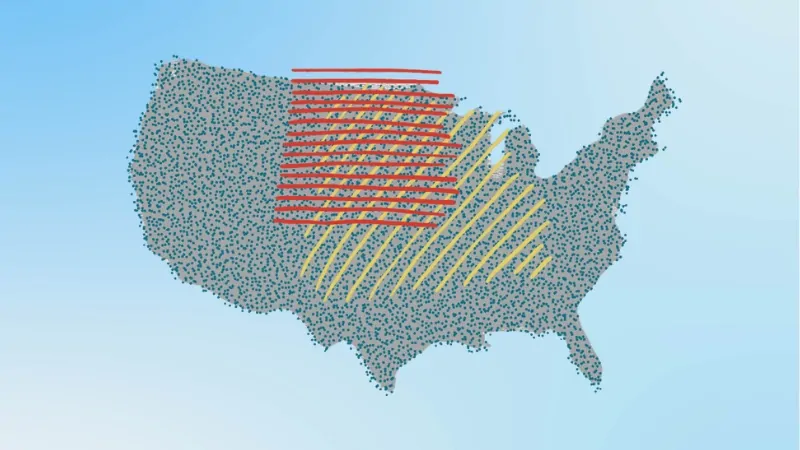For decades, the southern stretch of the U.S. known as the Sunbelt attracted millions seeking warmer climates, lower taxes, and more affordable housing. From Florida to Texas, the South saw a surge in newcomers, especially during the height of the COVID-19 pandemic, when remote work enabled people to relocate freely.
But that story is changing.
A growing body of research and fresh census data suggest that the Midwest—often dubbed the Snowbelt—is now pulling in more Americans, while migration to the Sunbelt has slowed. States like Wisconsin and Missouri, once struggling with outbound migration, are now welcoming new residents at increasing rates.
Meanwhile, traditional Sunbelt hotspots are seeing their momentum taper off.
A Pandemic Bump That Masked a Broader Trend
“The states with the highest average net inflows during the pandemic were all in the Sunbelt, led by Florida, Texas, North Carolina, and Arizona. Inflows moderated after the pandemic, but continued to be highest in the Sunbelt, led by Texas, Florida, North Carolina, and South…
— Richard Florida (@Richard_Florida) March 26, 2025
During the pandemic, states like Florida, Arizona, North Carolina, and Texas experienced a sharp rise in new residents. But according to new findings from Harvard’s Joint Center for Housing Studies, this surge was temporary and failed to reverse a longer-term shift already underway.
Before the pandemic, Midwestern states such as Missouri and Wisconsin were losing population. Now, however, they are recording net gains. States like Ohio, Michigan, and Illinois have seen their population declines slow considerably. In the Northeast, Connecticut has experienced a similar turnaround in outward migration.
At the same time, the migration rate toward the South has declined compared to previous decades.
The Climate Connection
This shift isn’t solely economic. Researchers at the Federal Reserve Bank of San Francisco, including economists Sylvain Leduc and Daniel Wilson, have documented a reversal in the longstanding migration pattern that once drew people from colder northern states to warmer southern ones.
Their findings suggest that rising temperatures due to climate change are playing a role. As the Sunbelt experiences hotter and more extreme weather, the formerly cold states in the Midwest and Northeast are becoming more livable year-round.
Warmer winters in the North and increasingly intense summers in the South are reshaping perceptions about where it makes sense to live long-term.
“The pivot in climate-related migration we’ve seen over the past 50 years appears to be continuing,” Leduc and Wilson noted. “We could be witnessing the reversal of a century-long trend.”
Housing Affordability Becomes a Driving Force
A key factor influencing this migration shift is the rising cost of living in the Sunbelt. According to Riordan Frost, a researcher at Harvard and author of the migration study, affordability is now a barrier, not only in traditionally expensive states like California or New York, but across the entire South.
“In many parts of the Sunbelt, home prices and rents have jumped significantly, making these areas less accessible than before,” Frost said.
Meanwhile, rural and suburban communities across the Midwest remain relatively affordable, even as urban housing markets across the country have grown increasingly expensive. This affordability is now helping these regions attract people who might have otherwise moved south in previous decades.
Less Movement Overall: The Bigger Picture
Despite these regional shifts, it’s important to note that overall U.S. mobility remains historically low. According to census data, the percentage of Americans moving homes has fallen from nearly 18% in the 1980s to under 10% today. While the pandemic temporarily disrupted that trend, the decline has since resumed.
One reason is economic. With home prices elevated, mortgage rates climbing, and a tight rental market, many Americans are locked into existing housing arrangements. Those who secured low-interest mortgage loans during 2020–2021 are especially reluctant to move and risk higher monthly payments.
“In general, homeowner mobility has plunged,” Frost explained. “That’s pulling down the national mobility rate quite a bit.”
What This Means Going Forward

The shift toward the Midwest and Northeast reflects a complex mix of climate adaptation, affordability, and demographic inertia. While the Sunbelt isn’t likely to lose population outright, its decades-long dominance as the top destination for movers may be fading.
States once overlooked—particularly in the Great Lakes region and interior Northeast—are gaining attention as they offer a blend of affordability, milder winters, and lower climate risks. Small towns and suburbs, in particular, stand to benefit as remote work continues to loosen ties to coastal job centers.
Whether this trend holds over the long term remains to be seen, but one thing is clear: the story of American migration is no longer just about heading south.
Related Posts:
- Collin, Tarrant, and Denton Counties Drive North…
- Medical Billing Is Changing Fast — What You’ll Be…
- Ranking America’s 21 Most Celebrated Holidays and…
- Thinking About an MSN in Forensic Nursing? Here’s…
- Can the Brain Truly Recover from Addiction? Here’s…
- Experts Are Testing a Free Way to Mimic Ozempic -…








